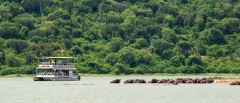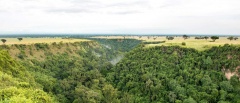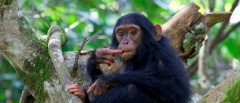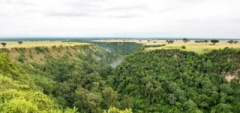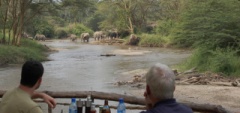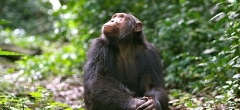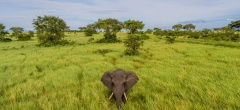Queen Elizabeth National Park
A park sitting on the Equator and famous for its tree-climbing lions
Founded in 1952, the Queen Elizabeth National Park is located in western Uganda and is formed of a variety of ecosystems homes just under 100 mammal species and over 600 bird species. As a result, for obvious reasons, is often included in a Uganda itinerary. Vast savannahs, lush forests, glistening lakes and fertile wetlands make it the perfect home for elephant, buffalo, lion, chimpanzees and hippo in particular.
The park was originally named Kazinga National Park but after a visit by Queen Elizabeth II, the name was changed to Queen Elizabeth National Park. Another interesting fact is that the park spans the equator line and a monument sits on either side of the road to mark the exact spot where it crosses latitude 0.
As if the park was not beautiful enough, the jagged Rwenzori Mountains are the backdrop to much of the park. Other features include of the park include the Kazinga Channel, the Katwe crater, Lake Edward, the Papyrus Swamps and the Ishasha River. These different ecosystems enable a varied safari experience, game drives and walks from your accommodation.
The remote Ishasha sector, in the southern part of the park, is famous for its tree-climbing lions. These lions enjoy spending hot afternoons snoozing up fig trees, are the most memorable sight in the entire park.
Queen Elizabeth National Park does not only provide fantastic wildlife experiences and sightings, but it also has a rich cultural background too. There are many opportunities for tourists to meet up with the local communities and be part of cultural activities like traditional dances, storytelling moments, and listening to traditional music. Community projects are also available to visit and get involved in, which can usually be organised through the lodge you are staying in, or through your tour operator beforehand.
When is best to visit Queen Elizabeth National Park
Like much of Uganda’s destinations, the park can be visited at any time of the year but the best experience, in terms of the game, is between the months of June and September. The months of December to January are also good times to go, as these are the dry seasons so the wildlife is more reliable as it tends to congregate around the permanent water sources.
The park is easy to combine with other destinations in Uganda, such as gorilla trekking in Bwindi, chimpanzee trekking in Kibale Forest, or to fly up to Murchison Falls in the northern region of Uganda.

